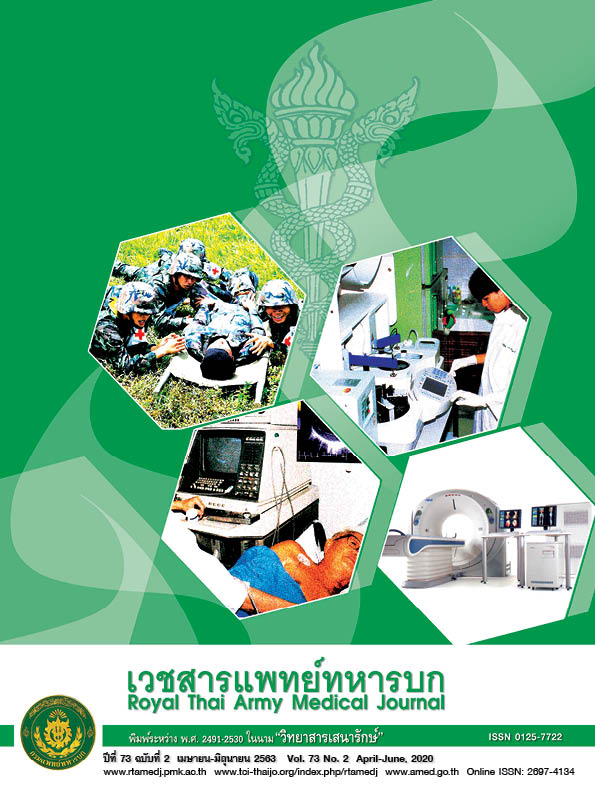ความน่าเชื่อถือและความตรงตามเกณฑ์สัมพันธ์ของแอนดรอยด์แอปพลิเคชันในการวัดช่วงการเคลื่อนไหวของคอ ในผู้ที่ไม่ปวดคอและปวดคอแบบไม่จำเพาะเจาะจง
Main Article Content
บทคัดย่อ
บทคัดย่อ
บทนำ: แอนดรอยด์แอปพลิเคชันนี้ยังไม่ได้รับการทดสอบความน่าเชื่อถือและความตรงตามเกณฑ์สัมพันธ์ในการวัดช่วงการเคลื่อนไหวของคอ
วัตถุประสงค์: เพื่อทดสอบความน่าเชื่อถือภายในผู้วัด ความน่าเชื่อถือระหว่างผู้วัด และความตรงตามเกณฑ์สัมพันธ์ของแอนดรอยด์แอปพลิเคชันในการวัดช่วงการเคลื่อนไหวของคอในผู้ที่ไม่ปวดคอและปวดคอ
วิธีการ: เป็นการศึกษาแบบภาคตัดขวาง เก็บรวบรวมข้อมูลจากอาสาสมัคร 2 กลุ่ม คือกลุ่มที่ไม่มีอาการปวดคอ และกลุ่มที่มีอาการปวดคอแบบไม่จำเพาะเจาะจง กลุ่มละ 30 คน โดยผู้วัดทำการวัดช่วงการเคลื่อนไหวของคอ 6 ทิศทาง โดยใช้แอนดรอยด์แอปพลิเคชันและ CROM™ ทดสอบความน่าเชื่อถือภายในและระหว่างผู้วัดโดยใช้สถิติสัมประสิทธิ์สหสัมพันธ์ภายในชั้น (ICC) และทดสอบความตรงตามเกณฑ์สัมพันธ์โดยใช้สถิติสัมประสิทธิ์สหสัมพันธ์เพียร์สัน (r) สัมประสิทธิ์สหสัมพันธ์ภายในชั้น (ICC) และ Bland and Altman plot
ผลการศึกษา: ผลการศึกษาพบว่าทั้ง 2 กลุ่มมีความน่าเชื่อถือภายในผู้วัด (ICC3,k≥0.870) และระหว่างผู้วัด (ICC2,k≥0.800) อยู่ในระดับสูงถึงสูงมาก กราฟ Bland and Altman plot แสดงให้เห็นว่าอุปกรณ์ทั้ง 2 ชนิดมีค่าความแตกต่างเพียงเล็กน้อย (≤3.79°) มีความสัมพันธ์ในการวัดช่วงการเคลื่อนไหวของคอของทั้ง 2 กลุ่มอยู่ในระดับสูงถึงสูงมาก (r≥0.708) และมีความสอดคล้องอยู่ในระดับสูงถึงสูงมากในกลุ่มที่มีอาการปวดคอ (ICC≥0.910)
สรุป: แอนดรอยด์แอปพลิเคชันนี้มีความน่าเชื่อถือและมีความตรงตามเกณฑ์สัมพันธ์ในการวัดช่วงการเคลื่อนไหวของคอทั้งในผู้ที่ไม่ปวดคอและปวดคอแบบไม่จำเพาะเจาะจง
Downloads
Article Details
บทความในวารสารนี้อยู่ภายใต้ลิขสิทธิ์ของ กรมแพทย์ทหารบก และเผยแพร่ภายใต้สัญญาอนุญาต Creative Commons Attribution-NonCommercial-NoDerivatives 4.0 International (CC BY-NC-ND 4.0)
ท่านสามารถอ่านและใช้งานเพื่อวัตถุประสงค์ทางการศึกษา และทางวิชาการ เช่น การสอน การวิจัย หรือการอ้างอิง โดยต้องให้เครดิตอย่างเหมาะสมแก่ผู้เขียนและวารสาร
ห้ามใช้หรือแก้ไขบทความโดยไม่ได้รับอนุญาต
ข้อความที่ปรากฏในบทความเป็นความคิดเห็นของผู้เขียนเท่านั้น
ผู้เขียนเป็นผู้รับผิดชอบต่อเนื้อหาและความถูกต้องของบทความของตนอย่างเต็มที่
การนำบทความไปเผยแพร่ซ้ำในรูปแบบสาธารณะอื่นใด ต้องได้รับอนุญาตจากวารสาร
เอกสารอ้างอิง
2. Quek J, Brauer SG, Treleaven J, Pua YH, Mentiplay B, Clark RA. Validity and intra-rater reliability of an android phone application to measure cervical range-of-motion. J Neuroeng Rehabil. 2014;11:65.
3. Kaonuan C, Mepayoung P. [Program for measuring range of motion using smartphone]. [B.Eng. thesis]. Phitsanulok: Naresuan University; 2016. Thai
4. Sterling M, Rebbeck T. The neck disability index (NDI). Aust J Physio Ther. 2005;51(4):271.
5. Hawker GA, Mian S, Kendzerska T, French M. Measures of adult pain: Visual analog scale for pain (VAS pain), numeric rating scale for pain (NRS pain), McGill pain questionnaire (MPQ), short-form McGill pain questionnaire (SF-MPQ), chronic pain grade scale (CPGS), short form-36 bodily pain scale (SF-36 BPS), and measure of intermittent and constant osteoarthritis pain (ICOAP). Arthritis Care Res. 2011;63 Suppl 11:S240-52.
6. Norkin CC, Joyce White D. Measurement of joint motion: A guide to goniometry. Philadelphia :F.A. Davis; 1995.
7. Nuttall FQ. Body mass index: obesity, BMI, and health: A critical review. Nutrition Today. 2015;50(3):117-28.
8. Tousignant-Laflamme Y, Boutin N, Dion AM, Vallée CA. Reliability and criterion validity of two applications of the iPhone™ to measure cervical range of motion in healthy participants. J Neuroeng Rehabil. 2013;10(1):69.
9. Audette I, Dumas JP, Côté JN, De Serres SJ. Validity and between-day reliability of the cervical range of motion (CROM) device. J Orthop Sports Phys Ther. 2010;40(5):318-23.
10. McKenzie R. The cervical and thoracic spine: Mechanical diagnosis and therapy. 2nd ed. Spinal publications; 1990. 161-62 p.
11. Koo TK, Li MY. A guideline of selecting and reporting intraclass correlation coefficients for reliability research. J Chiropr Med. 2016;15(2):155-63.
12. Chamnongkich S. [Measurement in physical therapy: Essential concepts and applications]. 1st ed. Chaing mai: Siampimnana; 2014. Thai
13. Hinkle DE, Wiersma W, Jurs SG. Applied statistics for the behavioral sciences. 4th ed. Boston, MA: Houghton Mifflin Company; 1998.
14. Giavarina D. Understanding Bland Altman analysis. Biochem Med (Zagreb). 2015;25(2):141-51.
15. Pourahmadi MR, Bagheri R,Taghipour M, Takamjani IE, Sarrafzadeh J, Mohseni-Bandpei MA. A new iPhone application for measuring active craniocervical range of motion in patients with non-specific neck pain: A reliability and validity study. Spine J. 2018;18: 447-57.
16. Atkinson G, Nevill AM. Statistical methods for assessing measurement error (reliability) in variables relevant to sports medicine. Sports Med. 1998;26:217–38.
17. Stenneberg MS, Busstra H, Eskes M, van Trijffel E, Cattrysse E, Scholten-Peeters GGM, et al. Concurrent validity and interrater reliability of a new smartphone application to assess 3D active cervical range of motion in patients with neck pain. Musculoskelet Sci Pract. 2018;34:59-65.
18. Nikolaos Strimpakos. The assessment of the cervical spine. Part 1: Range of motion and proprioception. J Bodywork Move Ther. 2011;15:114-24
19. Vaz S, Falkmer T, Passmore A, Parsons R, Andreou P. The case for using the repeatability coefficient when calculating test-retest reliability. PloS one. 2013;8(9):e73990.


